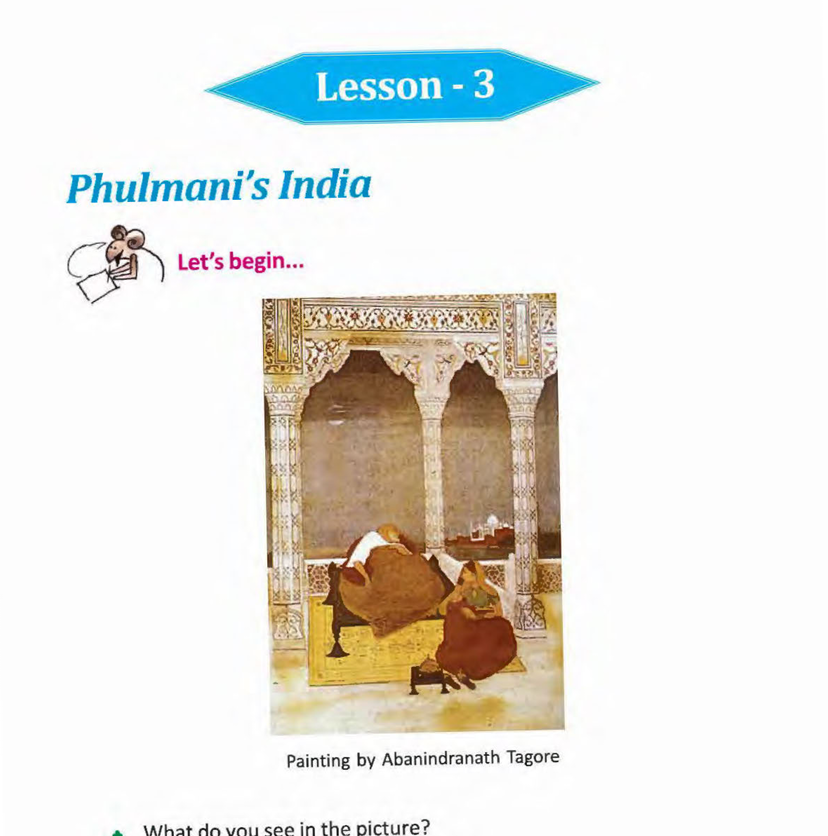
Butterfly Class 5 English Lesson 3 Question Answer Solved | Phulmani’s India is essential for young learners to build a strong foundation in the subject and butterfly class 5 lesson 3 question answer. Understanding the chapter thoroughly helps students grasp key concepts, improve comprehension, and perform well in exams.
In this article, Butterfly Class 5 Lesson 3, we provide detailed Butterfly Class 5 English Lesson 3 | Phulmani’s India Question Answer | Butterfly to make learning easier and more effective. Whether you are a student looking for well-explained solutions or a parent guiding your child, this guide will be a helpful resource for mastering the chapter with confidence. Also, we will include Class 5 English lesson 3 bengali meaning.
Read the complete summary of Phulmani’s India from Class 5 English. Explore paragraph-wise meanings in Bengali, MCQs, short and long questions with answers, and learn about India’s rich art, dance, music, and culture through Phulmani’s story.
Table of Contents
WBBSE Butterfly Class 5 English Lesson 3 Question Answers | Butterfly | Phulmani’s India
Phulmoni’s India Class 5 Summary in English
Phulmani is a Santhal girl residing in a remote village. Her abode has a variety of trees, flowers, and birds painted in and out of the house. She is a huge fan of such painting and her teacher says it is like how one of her ancestors has painted on the walls. She also goes to the mud-wall painting classes where the teacher explains that ancient people in India like and was painting on rocks and caves like those of Bhimbetka and Ajanta.
Phulmani has figured out already that Ajanta and Ellora are the cave of the oldest and the most prominent of the beautiful paintings and sculptures illustrating the three religions of Hinduism, Buddhism, and Jainism. Besides this, she is also a dancing girl. Her teacher narrates that many of the Indian dancing styles had their inception in temples. Examples of folk dances that people enjoy in different parts of India are Bhangra in Punjab, Dandiya in Gujarat, Bihu in Assam, and Chhau in West Bengal. The latter carrying the mask-dancers and beating-drum-backgrounds during the celebrations are the Phulmani’s foremost attraction.
One day, Phulmani accompanied her parents on a jatra. She was really delighted to see that. In due course, her teacher informed her that a jatra is a type of folk theater, similar to Tamasha in Maharashtra and Nautanki in North India. These performances often narrate tales from ancient myths and legends. Phulmani is also a singer and she knows about Indian musical instruments like sitar, tabla, and drums. She learns that ancient kings used to patronize music and dance in their courts.
Emperor Akbar was one of the very few who loved to listen to the mythic Tansen and was a known great singer in the world. India’s classical music is of two major forms – Hindustani and Carnatic. Phulmani feels pride in being an Indian. She wishes to visit the exquisite attractions like the Taj Mahal, Red Fort, and Buland Darwaza. Her happiness lies in being a citizen of a country so richly endowed with art, music, dance, and culture.
Phulmoni’s India Class 5 Summary in Bengali
ফুলমণি একজন সাঁওতাল মেয়ে, যে প্রত্যন্ত গ্রামে বাস করে। তার বাড়িতে ঘরের ভেতরে ও বাইরে নানা ধরণের গাছ, ফুল এবং পাখি আঁকা আছে। সে এই ধরণের চিত্রকর্মের একজন বিরাট ভক্ত এবং তার শিক্ষিকা বলেন যে এটি তার পূর্বপুরুষদের একজন দেয়ালে যেভাবে ছবি আঁকতেন ঠিক তেমনই। সে মাটির দেয়ালে আঁকার ক্লাসেও যায় যেখানে শিক্ষিকা ব্যাখ্যা করেন যে ভারতের প্রাচীন মানুষ ভীমবেটকা এবং অজন্তার মতো পাথর এবং গুহায় ছবি আঁকতে পছন্দ করত এবং করত।
ফুলমণি ইতিমধ্যেই বুঝতে পেরেছেন যে অজন্তা এবং ইলোরা হল হিন্দুধর্ম, বৌদ্ধধর্ম এবং জৈন ধর্মের তিনটি ধর্মের সবচেয়ে প্রাচীন এবং সবচেয়ে বিশিষ্ট সুন্দর চিত্রকর্ম এবং ভাস্কর্যের গুহা। এর পাশাপাশি, সে একজন নৃত্যশিল্পীও। তার শিক্ষিকা বর্ণনা করেন যে ভারতীয় নৃত্যশৈলীর অনেকেরই উৎপত্তি মন্দির থেকে হয়েছিল। ভারতের বিভিন্ন অঞ্চলে মানুষ যে লোকনৃত্য উপভোগ করে তার উদাহরণ হল পাঞ্জাবের ভাঙড়া, গুজরাটের ডান্ডিয়া, আসামের বিহু এবং পশ্চিমবঙ্গের ছৌ। উৎসবের সময় মুখোশ-নৃত্যশিল্পী এবং ঢোল-বাদ্যের পটভূমি বহনকারী নৃত্যশিল্পীরা ফুলমণির প্রধান আকর্ষণ।
একদিন, ফুলমণি তার বাবা-মায়ের সাথে যাত্রায় বেরিয়েছিলেন। তিনি এটা দেখে সত্যিই আনন্দিত হয়েছিলেন। সময়ের সাথে সাথে, তার শিক্ষক তাকে জানান যে যাত্রা হল এক ধরণের লোকনাট্য, যা মহারাষ্ট্রের তামাশা এবং উত্তর ভারতের নৌটঙ্কির মতো। এই পরিবেশনাগুলি প্রায়শই প্রাচীন পৌরাণিক কাহিনী এবং কিংবদন্তি থেকে গল্প বর্ণনা করে। ফুলমণি একজন গায়িকাও এবং তিনি সেতার, তবলা এবং ঢোলের মতো ভারতীয় বাদ্যযন্ত্র সম্পর্কে জানেন। তিনি জানতে পারেন যে প্রাচীন রাজারা তাদের দরবারে সঙ্গীত এবং নৃত্যের পৃষ্ঠপোষকতা করতেন।
সম্রাট আকবর ছিলেন খুব কম সংখ্যক রাজাদের মধ্যে একজন যারা পৌরাণিক তানসেন শুনতে ভালোবাসতেন এবং বিশ্বের একজন বিখ্যাত মহান গায়ক ছিলেন। ভারতের শাস্ত্রীয় সঙ্গীত দুটি প্রধান রূপের – হিন্দুস্তানি এবং কর্ণাটক। ফুলমণি একজন ভারতীয় হিসেবে গর্ব বোধ করেন। তিনি তাজমহল, লাল কেল্লা এবং বুলন্দ দরওয়াজার মতো চমৎকার আকর্ষণগুলি পরিদর্শন করতে চান। তার সুখ হলো এমন একটি দেশের নাগরিক হওয়া যেখানে শিল্প, সঙ্গীত, নৃত্য এবং সংস্কৃতি এত সমৃদ্ধ।
Activity 1 (Class 5 English Lesson 3)
Butterfly Class 5 Lesson 3 Question Answer
Tick the correct answer:
(1) The rock paintings of Bhimbetka are more than —- (b) 20,000 years old.
(2) Ajanta is famous for —-(a) Cave paintings.
(3) Bihu is a popular folk dance of —-(b) Assam.
Phulmani’s India Question Answer
Activity 2 (Class 5 English Lesson 3)
Butterfly Class 5 Lesson 3 Question Answer
Let’s match the dances with the states:

Answer:
- Chhau – West Bengal
- Dandiya – Gujrat
- Bhangra – Punjab
Also read:
Butterfly Class 5 English Lesson 1| India: Superpower in Cricket
Butterfly | Class 5 English Lesson 2| A Feat On Feet
Activity 3 (Class 5 English Lesson 3)
Butterfly Class 5 English Lesson 3
Let’s supply the missing information:
1. The primary colours used in the rock painting at Bhimbetka are red, white, green, or yellow.
2. Most of the Indian dances originated from the temples.
3. Sculptures are found in Ellora.
4. In the caves of Ajanta we find Fresco.
Activity 4 (Class 5 English Lesson 3)
Butterfly Class 5 English Lesson 3
Write T for true and F for false sentences in the given boxes:
1. In India there are many types of classical dances. [ T ]
2. Kathakali dance originated in northern India. [ F ]
3. Sitar is the musical instrument. [ T ]
4. In India there is only one form of classical music. [ F ]
5. Tansen was a great vocalist. [ T ]
Activity 5 (Class 5 English Lesson 3)
Butterfly Class 5 Lesson 3 Question Answer
Let’s write the answers to these questions:
(1) Which country has a rich heritage of classical dance?
Answer: India has a rich heritage of classical dance.
(2) What is an essential part of Indian classical dance?
Answer: Dramatics is an essential part of the Indian classical dance tradition.
(3) Who loved to listen to the songs of Tansen?
Answer: Emperor Akbar loved to listen to the songs of Tansen.
(4) Which monument in India is among the seven wonders of the world?
Answer: Taj Mahal is the seven wonders of the world.
(5) What is Buland Darwaza?
Answer: It is a monument of India, built by Emperor Akbar.
(6) Name the folk theatres of (a) Maharastra, (b) bengal, (c) North India.
Answer: The folk theatres of (a) Maharastra is called Tamasha, (b) Bengal is called Jatra, (c) North India is called Nautanki.
Also read:
Butterfly Class 5 English Lesson 1| India: Superpower in Cricket
Butterfly | Class 5 English Lesson 2| A Feat On Feet
Activity 6 (Class 5 English Lesson 3)
Butterfly Class 5 English Lesson 3
India is a country of dances. Find the names of these dances in this maze. One is done for you.
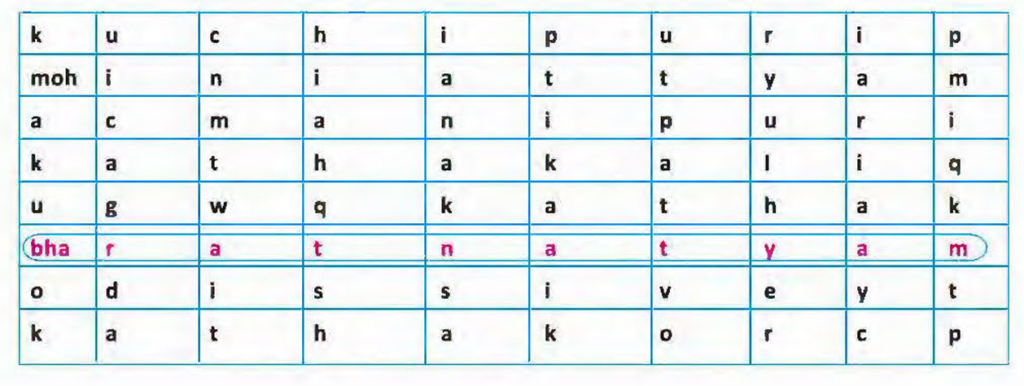
Ans:
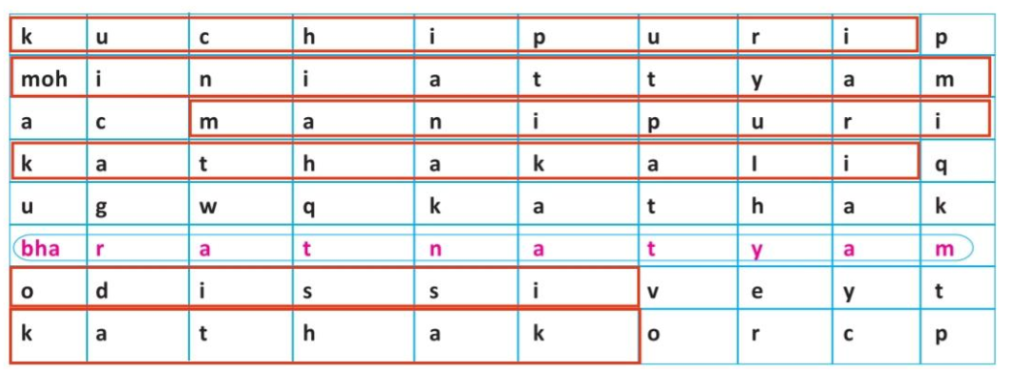
Activity 7 (Class 5 English Lesson 3)
Butterfly Class 5 English Lesson 3 Phulmani’s India Question Answer
Write the opposites of the words given in the clues. You can find the answers in the text:

Answer:
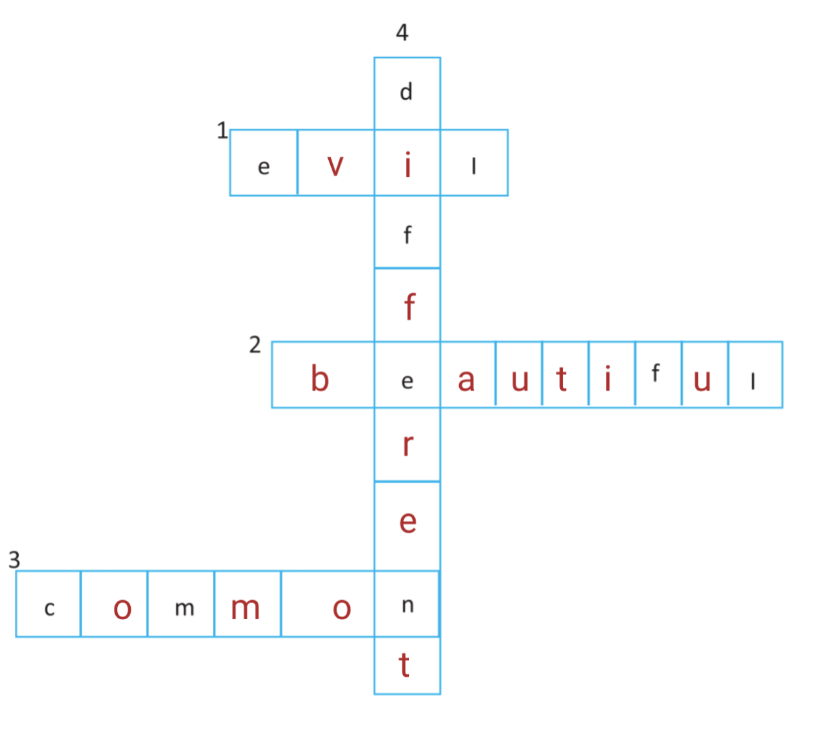
Clues:
Accross:
- Opposite of good = Evil
- Opposite of ugly = Beautiful.
- Opposite of rare = Common.
Down:
4. Opposite of same = Different.
Activity 8 (Class 5 English Lesson 3)
Butterfly Class 5 English Lesson 3 Phulmani’s India Question Answer
Write five sentences about the Tajmahal using the following hints:
Situated at Agra – beside river Yamuna – built of marble – tomb of Shah Jahan and Mumtaz Mahal – one of the seven wonders of the world.
Ans:
- The Tajmahal is situated at Agra beside the river Yamuna.
- This monument is built of marble.
- Saha Jahan built the Tajmahal in memory of his wife Mumtaj Mahal.
- This monument is a tomb of Shah Jahan and Mumtaz Mahal.
- The Tajmahal is one of the seven wonders of the world.
Also read:
Butterfly Class 5 English Lesson 1| India: Superpower in Cricket
Butterfly | Class 5 English Lesson 2| A Feat On Feet
Activity 9 (Class 5 English Lesson 3)
Butterfly Class 5 English Lesson 3
Let’s replace the bold words with a personal pronoun:
1. Jairam is a boy. Jairam studies in class V.
Answer: Jairam is a boy. He studies in class V.
2. This is a dog. The dog guards our house.
Answer: This is a dog. It guards our house.
3. Munmun is a little girl. Munmun goes to school everyday.
Answer: Munmun is a little girl. She goes to school everyday.
4. Ranu, James and Imran are friends. Ranu, James and Imran play together.
Answer: Ranu, James and Imran are friends. They play together.
5. We go to the city by bus. The bus goes fast.
Answer: We go to the city by bus. It goes fast.
6. I have a mynah. The mynah can talk.
Answer: I have a mynah. It can talk.
7. My father has a cycle. The cycle is red in colour.
Answer: My father has a cycle. It is red in colour.
Activity 10 (Class 5 English Lesson 3)
Phulmani’s India Class 5 Question Answer
Let’s underline the right answers:
1. Rabi has a little pet dog. He loves [her/his/their] pet dog.
Answer: Rabi has a little pet dog. He loves his pet dog.
2. I read in class V. [My/ Their/His] school is nearby.
Answer: I read in class V. My school is nearby.
3. Rina is my classmate. [His/Her/Its] house is near [its/their/our] school.
Answer: Rina is my classmate. His house is near our school.
4. My father is a painter. There are many paintings in [his/their/our] house.
Answer: My father is a painter. There are many paintings in our house.
5. My cousin sings well. [Their/Our/His] school has a music teacher.
Answer: My cousin sings well. Their school has a music teacher.
6. My dog wags [our/its/her] tail when it sees me.
Answer: My dog wags its tail when it sees me.
Also read:
Butterfly Class 5 English Lesson 1| India: Superpower in Cricket
Butterfly | Class 5 English Lesson 2| A Feat On Feet
Class 5 Butterfly Lesson 3 Question Answer
Activity 11 (Class 5 English Lesson 3)
Butterfly Class 5 English Lesson 3
Let’s fill in thr blanks with personal pronouns and possessive pronouns:
(1) The caves of Ajanta are famous for _______________ fresco paintings.
Answer: The caves of Ajanta are famous for its fresco paintings.
(2) Uday Shankar was a famous bengali dancer. __________________traveled all over the world with ________________ troupe.
Answer: Uday Shankar was a famous bengali dancer. He traveled all over the world with his troupe.
(3) Nandalal Bose was a great painter. We find ______________ drawings in “Sahaj Path”. ________________ was very close to Rabindranath Tegore.
Answer: Nandalal Bose was a great painter. We find his drawings in “Sahaj Path”. It was very close to Rabindranath Tegore.
(4) We are proud of ______________ greatest poet. Rabindranath Tagore.
Answer: We are proud of our greatest poet. Rabindranath Tagore.
(5) Taj Mahal was a built in the memory of Mumtaj Mahal. _____________ is a burial tomb.
Answer: Taj Mahal was a built in the memory of Mumtaj Mahal. It is a burial tomb.
Class 5 Butterfly Lesson 3 Question Answer
Activity 12
Butterfly Class 5 Lesson 3 Question Answer
Look at this comic picture and write five sentences about it:
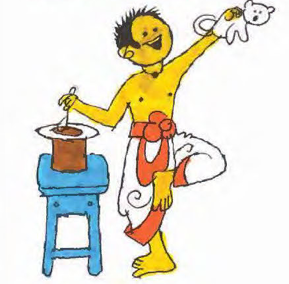
- The boy is a musician and he is very happy and exited.
- The boy is performing a magic trick.
- He is wearing a traditional dhuti.
- His body is yellow.
- There is a blue stool beside the boy.
Activity 13
Butterfly Class 5 English Lesson 3
Write five sentences about any dance performance that you have seen. Use capital letters at the beginning of sentences. End every sentence with a full stop:
1. I watched a beautiful Bharatanatyam dance performance last year.
2. The dancers wore colorful traditional costumes and jewelry.
3. The music was loud and made the dance exciting.
4. They moved their hands and feet very nicely.
5. Everyone clapped and enjoyed the dance a lot.
Also read:
Butterfly Class 5 English Lesson 1| India: Superpower in Cricket
Butterfly | Class 5 English Lesson 2| A Feat On Feet
Phulmani’s India Extra Questions And Answers
Phulmani’s India Class 5 MCQ Questions with Answers:
Comming Soon
Phulmani’s India Class 5 Short Answer Type Questions with Answers:
1. Who is Phulmani?
Answer: A Santhal girl living in a village.
2. What does Phulmani’s house look like?
Answer: It has colourful paintings on the walls and floors.
3. What does she like to paint?
Answer: Trees, flowers, and birds.
4. Who told Phulmani about ancient cave paintings?
Answer: Her teacher
5. Where are the rock paintings of ancient men found?
Answer: At Bhimbetka.
6. What is a fresco?
Answer: A wall painting made on wet plaster.
7. What do Ajanta and Ellora caves represent?
Answer: Art of Hinduism, Buddhism, and Jainism.
8. What kind of dancer is Phulmani?
Answer: A natural dancer.
9. Which dance form is from Punjab?
Answer: Bhangra.
10. Which dance is performed with masks?
Answer: Chhau dance..
11. What did Phulmani see with her parents?
Answer: A jatra performance.
12. What is jatra based on?
Answer: Mythological incidents or characters.
13. What is folk theatre called in Maharashtra?
Answer: Tamasha.
14. Which are South Indian classical dance forms?
Answer: Bharatnatyam, Mohiniyattam, Kuchipudi, Kathakali.
15. What are the Eastern Indian dance forms?
Answer: Manipuri and Odissi.
16. What musical instruments does Phulmani know?
Answer: Sitar, tabla, sarangi, and drum.
17. Who patronised music in India’s royal courts?
Answer: Indian kings and emperors.
18. Who was Akbar’s favourite musician?
Answer: Tansen
19. What are India’s main classical music styles?
Answer: Hindustani and Carnatic.
20. What monuments does Phulmani wish to see?
Answer: Taj Mahal, Agra Fort, Red Fort, and Buland Darwaza.
Phulmani’s India Class 5 Long Answer Type Questions with Answers:
1. Describe Phulmani’s love for painting and what she learned from her teacher.
Answer:
Phulmani loves painting on mud walls like her elders. Her walls are full of beautiful pictures of trees, birds, and flowers. Her teacher told her that even in ancient India, people painted on caves and rocks, like in Bhimbetka, where paintings are more than twenty thousand years old. This made her proud of India’s artistic heritage.
2. What did Phulmani learn about Ajanta and Ellora caves?
Answer:
Her teacher showed her pictures of Ajanta paintings, which are frescoes painted two thousand years ago. The caves of Ajanta and Ellora show the art of Hinduism, Buddhism, and Jainism. These places represent India’s unity in diversity through art.
3. Explain the different folk dances mentioned in the story.
Answer:
The story mentions several folk dances of India – Bhangra of Punjab, Dandiya of Gujarat, Bihu of Assam, and Chhau of West Bengal. Phulmani loves watching Chhau dance, where dancers wear masks and dance to the rhythm of drums and music.
4. What did Phulmani learn about music and musicians of ancient India?
Answer:
Phulmani learned that Indian kings loved music and supported it in their courts. Emperor Akbar loved to hear Tansen sing. She also learned about instruments like sitar, tabla, and sarangi, and the two main classical music styles – Hindustani and Carnatic.
5. Why is Phulmani proud to be an Indian?
Answer:
Phulmani is proud because India is full of great art, music, dance, and monuments like the Taj Mahal and Red Fort. She feels lucky to belong to such a culturally rich country and dreams of travelling all over India to see its beauty and heritage.

12 thoughts on “Phulmani’s India | Class 5 English Lesson 3 Question Answer Solved | Butterfly | Ultimate Guide”